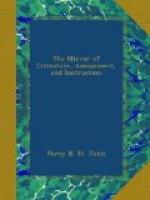On the death of Prince Edwin, Athelstan himself presided over the lodges; but after his decease, we know little of the state of the masons in Britain, except that they were governed by Dunstan, Archbishop of Canterbury, in 960, and Edward the Confessor in 1041. But in 1066, William the Conqueror appointed Gondulph, Bishop of Rochester, to preside over the society. In 1100, Henry the First patronised them; and in 1135, during the reign of Stephen, the society was under the command of Gilbert de Clare, Marquess of Pembroke.
From the year 1155 to 1199, the fraternity was under the command of the grand master of the knights templars.
In 1199, Peter de Colechurch was appointed grand master; and the society continued to increase and flourish in the successive reigns of Henry III., Edward I., Edward II., and Edward III. This last prince revised the constitutions of the order, and appointed deputies to superintend the fraternity, one of whom was William a Wykeham, afterwards Bishop of Winchester. He continued grand master under the reign of Richard II.; was succeeded by Thomas Fitz Allen, Earl of Surrey, in Henry IV.’s reign; and on Henry V.’s accession, Chichely, Archbishop of Canterbury, presided over the society. We have records of a lodge held at Canterbury, under his patronage, where Thos. Stapylton was master, and the names of the wardens and other brethren are given. This was in 1429, four years after an act of parliament, passed early in the reign of Henry VI., against the meetings of the society, which was caused by the enmity of Cardinal Beaufort, Bishop of Winchester, towards Humphrey, Duke of Gloucester, the king’s uncle, a great patron of the craft. But this act was never enforced, and in 1442 the king was himself initiated, and he patronised the society.
In the meantime, under the auspices of James I. of Scotland, masonry flourished in that country. It had been nursed, during the wars which ravaged Europe, in the humble village of Kilwinning, in the west of the country; from whence it at length burst forth, and communicated its light to the lodges in the south. The records of this lodge actually go back to the beginning of the fifteenth century, as also do those of a lodge in or near Edinburgh. And about this time the Scottish king appointed a fee to be paid by every master to the grand master, who was chosen by the grand lodge. James II. of Scotland made the grand mastership hereditary, and conferred it on the St. Clairs of Roslin, in which family it continued till 1736, when the then representative of the family, being old and childless, resigned it into the hands of the grand lodge, then first established on its present footing, by whom he was re-elected grand master for life.
During the civil wars in England masonry declined; but on the accession of Henry VII., in 1485, it revived again, under the patronage of the grand master of the order of St. John, at Rhodes, who, in 1500, chose King Henry their protector. In 1502 this king presided in person in a lodge of master masons, and proceeded in ample form to lay the foundation of the chapel, at the east end of Westminster Abbey, which bears his name.




